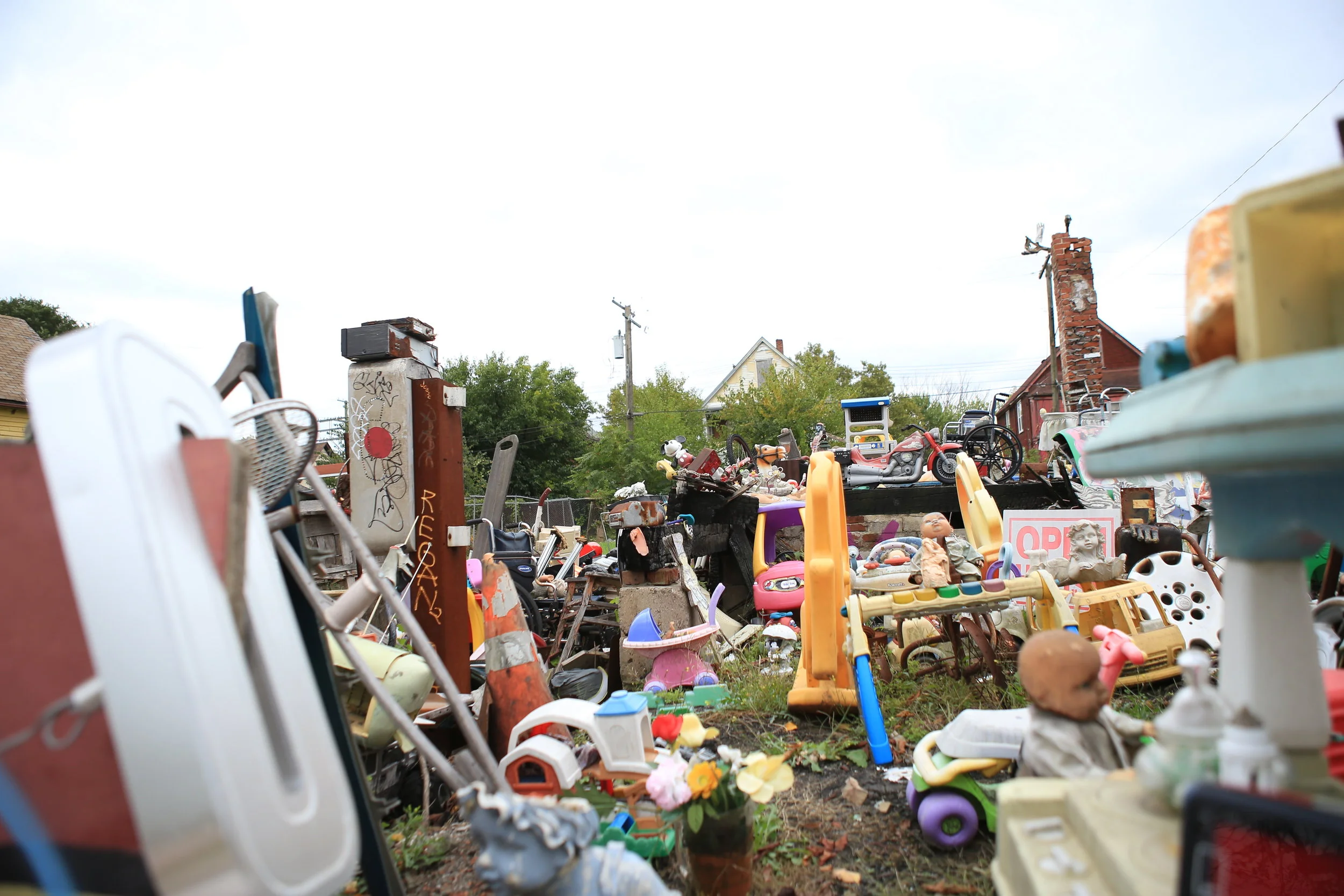AP Guest Blog featuring Mia Saba
Earlier this year, I was approached to edit a short film to be shown at a lecture at the Grand Rapids Art Museum given by Jenenne Whitfield, President of the Heidelberg Project. The client had previously been involved in another film relating to the Heidelberg Project, and had all of the footage and files on an external hard drive (along with the express rights to its use). The goal was to take a previously assembled film (which clocked in at about 40 minutes in length) and to pare it down to 10 minutes or less, focusing the specific message of the film on one of the core principles of the Heidelberg Project - art as a medicine.
I began by sitting down with the client to discuss what he had, and what he wanted. He provided me with some notes on the existing film, identifying specific ideas or messages that he thought would help support the concept of the new project. He also expressed a concern with the existing full-length film - that the graphics and transitions were, while nicely executed, perhaps a bit of a distraction from the underlying message. We talked about the Heidelberg Project itself; and of his connection to the film and to Tyree Guyton, the artist behind it all. I left with a hard drive containing about a terabyte and a half of content, and six days to complete the new film.
After transferring all of the files (I duplicated everything onto another hard drive, to protect all of the originals), I spent about a day and a half reviewing all of the footage. I made notes along the way, essentially summarizing everything that I had viewed, noting time stamps of specific clips that I thought would be relevant to the project and its message. I’ll admit, initially, I felt a bit overwhelmed - I had hours upon hours of content to squeeze into ten short minutes. But in a way, this was an editor’s dream come true - this hard drive contained an embarrassment of riches - quality video footage and still photographs, clean audio, and an absolute jackpot for the score (more on that later). I sat back and listened as Tyree and Jenenne spoke of both the history, and future, of the Heidelberg Project, and of the tremendous impact it has made (and continues to make), not only on the city of Detroit but on the lives of everyone who experiences it ("Heidelberg Magic").
I began with a new timeline in Premiere Pro, pulling in clips that I had previously noted to create a basic “skeleton” of content. Because of the time limitation for the final product, I had to get creative in cutting the interview footage of Tyree and Jenenne. The challenge was to cut and splice their dialogue in a way that focused the message of the film as clearly and concisely as possible, without manipulating what they had actually said. My goal was to structure the content in a way that defined and reinforced their story as efficiently, and effectively, as possible, and I was incredibly fortunate to have such a wealth of amazing files and footage at my fingertips.
After assembling a rough cut of the film, I began working on the score. I was faced with the decision to either find an existing piece of music that would generally “fit” (and then re-manipulate my timeline to correspond with it) or to compose a new track from scratch, for which I truly did not have the luxury of time. The hard drive I was given contained a “music” folder and much to my surprise, rather than a single track that ran the length of the original film, it contained dozens of musical components; individual guitar licks and riffs, which gave me a substantial foundation on which to build a custom score for the new film. I felt like I had won the lottery.
I dropped the individual music files into my Premiere timeline to fill in the gaps between interview segments, using longer, more subdued clips under the dialogue to tie everything together. This had a huge impact on the tone and feel of the film - it was finally starting to take shape.
After a bit more tweaking and polishing of my timeline, it was time to move into After Effects. I created new compositions for each set of clips (combining similar footage, such as interview sequences, into one composition to ensure uniformity in my color correction). I’ll admit, I had to resist the temptation to add some punchy visual effects - this was a case where less would truly be more. This story didn’t need sparkling graphics and dynamic transitions to help tell it; it simply needed to be told.
As my deadline quickly approached, I continued to fine-tune my timeline, frequently exporting and uploading so I could view it on every device in my home in hopes of identifying additional last-minute improvements (and of catching things that I had previously missed). I didn’t sleep much during the week I spent working on this film, but I don’t think I slept at all the night that I sent it off for review. As with any project, I wanted the client to be happy with my work, but it was especially important to me in this case. As an artist myself, I felt a connection to the project the moment it was presented to me, but the more time I spent listening to Tyree’s story and message, the more I heard it and felt it. That Heidelberg Magic.
Somehow this project came to me at exactly the right time. I’ll spare the details, but I had experienced a great deal of loss in a very short time. I was trying to push forward in my career (and life) while working through a mounting backlog of grief, and I can’t say that I was doing a great job of it. Initially, this project seemed like an excellent distraction, but it proved to be so much more than that. It seems silly to say, but at times it felt as though Tyree, in his interview, was talking directly to me; somehow knowing exactly what I needed to hear at that exact point in time.
I had known of Tyree and his work prior to my involvement with this film, but that week I learned more about him than most of my friends probably know about me. His openness and willingness to discuss some of the most painful and traumatic events of his life, and his unwavering belief in the work that he does, drew me into this project in a way that I’ve never before experienced. This wasn’t just something to work on, complete, and then move on from. It was something that I wanted to be a part of as much as it had become a part of me.
Because we had begun with such a tight deadline, the final review process had to go smoothly; and fortunately, it did. I received excellent feedback and had just enough time to make a few final adjustments before forwarding the final cut to the crew at the Grand Rapids Art Museum. They opened the lecture by showing my film; 10 minutes later, as the credits faded and the lights went back up, I could finally breathe.
It was really exciting to hear Jenenne talk about the current and future states of the Heidelberg Project. I had been so consumed by the stories contained on that hard drive, I had forgotten that I had basically traveled back in time and experienced Heidelberg circa 2014 (which is quite different than where it stands today). I was especially thrilled to find out that the magic will continue, and while it may begin turning in a new direction, the momentum behind it is stronger than ever.
The sigh of relief after successfully completing another project was, in this case, bittersweet. I felt as though I had spent the week living on Heidelberg Street with Tyree and Jenenne, and now it was time to go home. I knew that wouldn’t be the end of my relationship with the project, but I wasn’t sure of exactly how it would continue. I nearly fell out of my chair when I found out that the film would also be shown at the 360° of Heidelberg Conference in Detroit, and that I would have the chance to finally meet Tyree.
It’s bizarrely surreal, meeting someone who you feel as though you've known for years for the very first time, and trying to communicate the impact they have had on your life with the brevity of “nice to meet you ... I’m a fan of your work”. I had but one single goal for the day - to keep myself from going full-on “fan girl”. You want this to be the beginning of something, I told myself, so don’t embarrass yourself.
At one point, Tyree turned to me and said, “you’re a part of this now”. As that began to sink in, I recalled joking with Jenenne months earlier, telling her, “you’re going to have a hard time getting rid of me”.
A very special thank you to Dr. Richard Raubolt, Director; Dr. Kirk L. Brink, Producer; Tyree Guyton, Artist/Creator of the Heidelberg Project; Jenenne Whitfield, President of the Heidelberg Project; and Mike July of MoxieMen, Inc.
For more information on the Heidelberg Project, visit www.heidelberg.org









